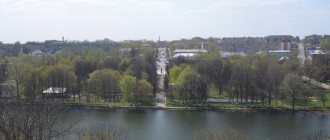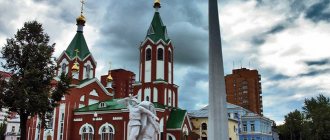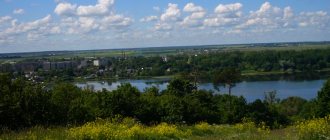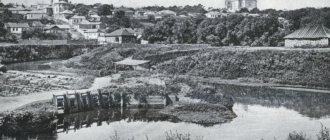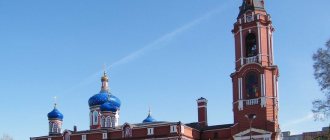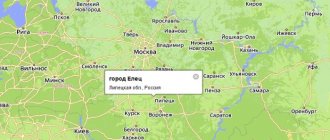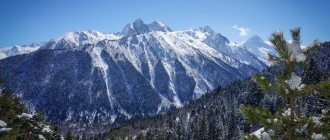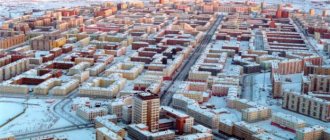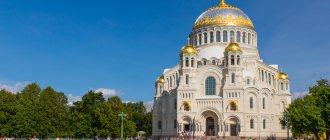Wonderful vacations and vacation trips have become commonplace in warm places on our planet. Especially if small children are involved in the trip. Times change. Fans of active recreation and distant travels through the historical sites of their homeland are increasingly finding the most mysterious, remote, lost in time, cities, towns, and natural attractions. I would like to see in reality the living conditions of grandfathers and grandmothers, whose fate is connected with the wild, cold North.
Such a place is the easternmost city in Europe, which grew up in the Arctic Circle, called Vorkuta. You can come here with the whole family on your own or take advantage of well-organized tourist excursions that tell you what you can see in Vorkuta. You can get to the city by train in any month of the year. Vorkuta is always interesting: short summers, long harsh winters with unforgettable polar lights.
Modern Vorkuta
This is not an ancient city found in archaeological excavations such as Arkaim in the Urals. The western slopes of the Ural Mountains protect the city, and the Arctic Ocean is just 180 km away. Vorkuta received city status in 1943 after the discovery of the Pechora coal basin with large reserves of hard coal.
A beautiful city, created by human efforts in the middle of the wild tundra, in the darkness of the polar nights, has a complex history, has experienced a severe economic recession, but it is alive and has preserved many of its attractions. The city is warm, schools, kindergartens, and sports complexes are open. Theatres, cinema halls, cafes, entertainment centers. Miners working in the villages of the Vorkuta Ring have places to relax and spend family leisure time. Now it has a small airport with regular flights, a terminal with the ability to receive aircraft such as An-24, Yak-40, other types, and helicopters. You can order a Vorkuta transfer in advance to quickly get to the interesting, snowy world.
During the trip you can see the Marble Canyon, icy mountains, be frozen by pictures of the northern lights, learn about the life and customs of the reindeer herders who live in the tundra. Sleds with reindeer in harness often drive along the central streets of the city. They are run by local residents wearing special fur clothes. Some live in the city and work on a reindeer herding state farm. Reindeer herders wander along with the herd across new pastures. Their life takes place in a modern tent, equipped with a diesel power plant, television, radio, and cell phones.
Fast snowmobiles coexist next to ancient sledges. Participation in the festival of reindeer herders, held in November, can be considered good luck. During this period, interesting reindeer races are held here, and the Polar Games are held with the participation of athletes from many Russian cities.
Parks and monuments, streets
Monument-steam locomotive "Em 720-24" in Vorkuta
Address: railway station
The locomotive was erected on the pedestal in 1980 as a monument to steam locomotive engineering. The car itself was made in 1924 at the Kolomensky plant.
It was installed in honor of the builders of the railway in the Arctic.
It was on this locomotive that the first batch of Vorkuta coal was delivered to Leningrad in 1944 in honor of the lifting of the blockade.
Recognized as a cultural heritage of the Russian Federation.
Monument to soldiers who died defending the Motherland in Vorkuta
Address: pl. Victory
Initially, only a monument to soldiers was erected on the square based on the sketches of 15-year-old Sasha Stepanova. The top of the monument - the storks' nest - weighs more than five tons.
It was manufactured at the local Vorkuta Mechanical Plant. In 2001, a park was built here and 350 trees were planted.
Sign "Vorkuta 67 parallel"
Address: intersection of Usinskaya, Aviatsionnaya, Matveeva streets
They decided to install the sign in honor of the 40th anniversary of Vorkuta and the 50th anniversary of the opening of the Pechora coal basin. The diameter of the sign is 14 meters and the height is 4 meters.
Initially, the monument was a decoration of the new road from the coal mines, but over time the city grew, so now it is located almost in the center of Vorkuta.
What to see in Vorkuta
Ancient sights and mysterious churches with wooden domes cannot be found in the city. The five best sights of Vorkuta related to the history of the city and country can be seen starting from the station:
Lenin Street
Lenin Street starts from Metalworkers' Square. You must walk along it to feel the atmosphere of the birth of the city. A huge building of not bright colors “Vorkutaugol” with the famous monument at the entrance. It is dedicated to the geologist who discovered the Pechora deposit, A. Chernov.
Miners' Palace of Culture
Powerful columns, sculptures, and a marble fountain decorated this creation of a bygone era. Previously, there were marble figurines of bathing bears near the fountain. In front of the palace there was a monument to Lenin. His figure towered against the backdrop of the mysterious mountains of the Urals. The bas-relief standing next to the monument depicted the stages of development of the USSR. This is the most beautiful old building in the city, located on Peace Square.
Museum of Local Lore
It is located at st. Lenina, 38. The first exhibitions in the museum were dedicated to interesting natural places in the region. What can you see in Vorkuta in winter? Visit the unique museum exhibitions telling about the life of people at the edge of the world.
Yubileinaya Square
The answer to the question of what to see in Vorkuta is to walk around the square.
The buildings of the mining college and drama theater are located here. The theater was created in 1943 for political prisoners, among whom there were many creative intellectuals: musicians, singers, artists, writers. For example, the fate of the professor of the Moscow Conservatory, chief director of the Bolshoi Theater B.A. Mordvinov, who staged the famous opera “Ivan Susanin”, is associated with the theater. The walls of the theater heard the sound of the operas “Faust”, “The Barber of Seville”, “The Circus Princess”, “Silva”, etc.
Residential buildings on Moskovskaya and Lenin streets
They personify the classic architectural style of urban planning of the Leningrad architectural school of the past five-year plans. The semicircular shape of the houses, characteristic of Vorkuta, is interesting. The facade of the buildings was on the western side, protecting the houses from severe snowstorms in winter. The foundation of such buildings was most often erected on stilts and by freezing the soil. Until now, a large number of houses are decorated with posters and signs of Soviet themes. This gives the impression of a frozen Soviet era. Walking along Shakhterskaya Embankment, looking at the abandoned houses of the first place of settlement, you can get a sense of the border between the past and present of Vorkuta.
Historical sites and museums
Vorkuta Museum and Exhibition Center
Address: st. Lenina, 58 Phone: +7 82151 3‑11-05, +7 82151 6‑00-43 Website: https://museumworkuta.ru Opening hours: Tue-Sun 10:00–17:00 Cost: preschoolers - 10 rubles ., schoolchildren, students - 12 rubles, adults - 40 rubles, free for pensioners
The museum was opened in 1960, the first exhibitions told about the history of the region, the development of the coal industry and the life of the population.
The Vorkuta Musical and Drama Theater donated posters and programs from the very first productions to the museum’s collection. Objects of camp life were brought from the camps: chess made from bread crumbs, playing cards.
In total, the funds contain more than seven hundred items made by the hands of prisoners, including postcards and issues of the Zapolyarnaya Kochegarka newspaper. The stands display the craftsmanship of the indigenous peoples - the Nenets and Chukchi - bags, clothes, toys and jewelry.
After the excavations, musk ox and cave bear skulls, bones and mammoth tusks were transferred to the museum fund. There are more than fourteen thousand historical finds in the museum, and the collection is constantly growing.
Exhibitions of paintings and photographs are held in a separate room.
Vorkuta Museum of Local Lore
Address: st. Lenina, 38
The museum is part of the exhibition center; previously, most of the exhibition there was the history of the Gulag.
The building is currently undergoing restoration and is not accessible to the public. All exhibitions have been moved to the village of Vorshagor.
Abandoned village of Rudnik
Address: Vorkuta How to get there: from Lenin Street to Rudnik on foot along the left bank
It was here that Vorkutlag, one of the largest branches of the Gulag, began. The village was founded before the city, but today no one lives in several dozen houses.
Now the territory of the village is used for paintball and airsoft games.
Open-air museum of military equipment on Victory Square
Address: pl. Victory
Various military equipment is installed on the square: a BMP-1 infantry fighting vehicle, a T-55 tank, a 122 mm cannon of the 1931-1937 model, an 85 mm D-44 cannon, a Mi-8 helicopter, a 122 mm howitzer of the 1938 model.
The festive procession on Victory Day begins from here every year.
The museum is surrounded by flowers and benches.
What to see in Vorkuta with children
The best time to relax with children in Vorkuta is summer from June to September. Beautiful golden autumn begins here in August. At this time, there are different options for where to go in Vorkuta with a child:
Historical places of Vorkuta
Walk through historical places. Learn about the city by walking along the ancient bridge connecting the historical center (the village of Rudnik) with the residential area of the current city. Unfortunately, only empty window sockets in once lively houses and the wind whistling across the floors greet tourists here. But you can't get rid of your history. Children must be told about their former life. The first settlers came here along the once navigable Vorkuta River to build their difficult lives. Maybe someone’s relatives are buried in local cemeteries, their descendants still live in this city. And the sparkling lights of the windows of the houses standing on the opposite side of the river give rise to the desire not to turn Vorkuta into a lost, northern world. Monuments called the Monument, the Gulag cross, Victory Boulevard will preserve information about the difficult events of the country for a long time
Cultural recreation in Vorkuta
The city regularly hosts exhibition halls, galleries, interesting thematic exhibitions, and modern game rooms. In the puppet theater located in the Miners' House, you can watch an interesting children's performance. The large exhibition hall of the Komi Republic often hosts interesting exhibitions of children's drawings. The Vorkuta Art School creates conditions for the diverse development of local children. It is interesting to take part in thematic excursions of the Vorkuta Museum of Local Lore. These are “Front-line Vorkuta”, “Wildlife of the Tundra”, “Ancient Pechora Region”, and others.
Camping
Enjoy an active holiday on unforgettable hikes with your children in the northern region. This can be done in tent camps near the banks of the Sob and Kara rivers. Master water routes, snowmobile, helicopter, and car tours in the Far North. At the Yubileiny stadium you can rent any vehicle and, for example, ride a bicycle through the city streets and surrounding areas. Where all-powerful glaciers formed unforgettable landscapes. The sight of the Paemboy Rocks, the northernmost geological natural monument in the republic, is of great interest to children and adults. At the top of Mount Paemboy there is a helicopter pad and an observation tower. On clear days, you can look at the endless expanses of the Bolshezemelskaya tundra and see the mountains of the Polar Urals.
Entertainment
Polar Drama Theater
Address: Yubileinaya Square, 1 Phone: +7 82151 3‑12-65, +7 82151 3‑61-27 Website: vorkutadramteatr.com Opening hours: Tue-Sun 12:00-18:00 Cost: 350-600 rubles
The theater was founded by political prisoners in 1943. During the Great Patriotic War, more than 600 performances were performed, in which 150 people participated. When the camp was closed in 1950, the theater began staging plays by classics and touring the USSR.
Nowadays, performances based on the works of contemporary authors are performed here, as well as festive performances and performances for children.
The first performances were held at the Miners' Palace of Culture in the village of Rudnik; a separate building was rebuilt in 1946, but it burned down in 1958. The theater received its current premises only in 1963.
Komi Republican State Puppet Theater
Address: Mira Square, 1 Phone: +7 82151 3‑16-64, +7 82151 3‑52-41 Website: https://kuklyvorkuta.rf Opening hours: Mon-Fri 9:00-17:00 Cost: 150 -380 rubles, free for WWII participants, disabled people of groups I, II, orphans
The first puppet shows were staged by prisoners, and they made the puppets and all the equipment themselves. Even the building - the Miners' Palace of Culture - was erected by them.
Officially, the status of a theater was assigned in 1955, but there was never a separate room. In the palace, a hall for 150 people was then allocated for the needs of puppeteers, and only in 2000 the former cinema was renovated for them.
The theater is a regular participant in the festival in Finland, and also tours throughout Russia.
Most of the performances are based on the folklore of the peoples of the Komi Republic.
What to see in the vicinity of Vorkuta
Along with the city, its surroundings grew, filling with small villages and a ring road connecting small settlements. Now many of them have become empty, without people, with the walls of residential buildings remaining. The picture is reminiscent of filming fantastic ghosts of eternity. Only near active coal mines can you see signs of human life. The bulk of the workers moved to Vorkuta. They get to their workplaces through organized routes.
The pathetic vegetation of the shrub tundra came close to the dwelling. During an organized excursion to the immediate surroundings, it is interesting to find out what no one knows about Vorkuta, listen to the following information:
Village Khalmer - Yu
The village of Halmer - Yu or translated as “River in the Valley of Death”. Local residents considered this place sacred and used it as a cemetery. The terrible stories of 1995 are associated with the decision to liquidate the village. Residents were forcibly taken to Vorkuta, resettled in hostels, and their homes were blown up. Nowadays there is a military training ground on the territory of the village, called “Pemboy”. And very close (25 km from the village) there is a hydrological natural monument called a waterfall on the Halmer-Yu River. This is the largest waterfall in the Republic and one of the largest waterfalls in the European regions of Russia. This place has a fascinating water route, loved by many tourists. You can't go through it. Usually they set up camp at the waterfall and stop to explore the surrounding area, including the Pemboy Rocks.
Vorgashor village
Together with the village of Severny, it preserved the opportunity for people to live and work. Public transport comes here regularly from Metallistov Square in Vorkuta. The largest settlement on the Vorkuta Ring was founded in 1964 along with the opening of the Vorgashorskaya mine, which is still in operation. In the village, with the name “stream by the deer path,” there are abandoned houses next to residential buildings. Among them there are well-groomed houses painted with multi-colored paints. In the center of the village there is a square decorated with an obelisk in the form of a cube glorifying coal.
Natural monuments
The surroundings of Varkuta have a unique nature that attracts scientists and tourists from all over the world. In the Vorkuta region there are two reserves and five natural monuments. Among them are the Khrebtovy, Enganepa, Vorkutinsky nature reserves, and the swamp monument At the Yun-Yaga Farm. The biggest spectacle is the northern lights. In winter, emerald, red, and white pictures can be seen in the sky throughout the polar day. In summer, the beauty of extraordinary white nights and a surprisingly long-lasting tan attract lovers of the Far North.
Village Rudnik
In the western part of the city, on the right bank of the Vorkuta River, there is an abandoned working quarter. This is where the city began in the 30s of the last century. Today, the mine is a sad sight - several dozen uninhabited and dilapidated houses. You can get here from Shakhterskaya embankment along the old suspension bridge.
The mine was resettled back in the 1990s due to unprofitability. Its former inhabitants received apartments on the opposite bank of the river - directly in Vorkuta. After crossing an emergency and rather dangerous bridge over the river, you find yourself in an abandoned village. The first thing that will greet you here is a rusty obelisk, and behind it is a beautiful three-story building of the former palace of culture. A railway track runs over the village, leading to the still operating Vorkutinskaya mine.
Where to go in Vorkuta
After difficult mining work, you can visit the theater, cinema, restaurant, cafe, night club, and play sports. The city's cinemas are equipped with modern technology and equipment. The best cinema hall in the city is considered to be the Cascade cinema, located on the central square of the city. The average cost of tickets in 2D format is 150 rubles . For 3D format the ticket price is 250 rubles . On the current website you can always pre-order a ticket at a specific price.
You can buy tickets for any theatrical production at the theater box office or from distributors. All information is regularly updated on the website. Ticket prices vary, depending on the location and production, ranging from 250 to 1500 rubles . The cost of lunch in a restaurant, when ordering very tasty dishes of local and European cuisine, can cost from 800 to 3000 rubles .
Temples of Kursk
Kursk (the sights of the city are associated with its religious significance) has a large number of religious buildings:
- Znamensky Cathedral. Its construction is intended to commemorate in history a great event for the Russian people—the complete defeat of Napoleon’s armies. Based on classicism, the architect also used elements of the Western European Renaissance, which is the main distinguishing feature of this temple. The top view is cross-shaped with an elongated western part. The name of the cathedral was given by the Miraculous Icon of the Mother of God “The Sign” that was previously stored in it. Just behind the cathedral is the colorful Church of the Resurrection, which is inaccessible to visitors.
- Resurrection-Ilyinsky Church. Previously confined to the outskirts of the House of Books, the Resurrection and Elijah Church was not visible from the street. But the architects built the wall of a nearby bank at such a height and at such an angle that the mirror image of the church became visible in the bank's windows. In the interior there are frescoes painted according to Vasnetsov’s sketches. The Orthodox Saint Seraphim of Sarov was baptized in this church as an infant. Now services are held in the Elias Church. Location - center.
- Church of the Life-Giving Trinity. It is officially believed that the oldest premises of the Trinity Cathedral were built between 1733 and 1740. At the beginning of the twentieth century. South and North extensions with altars were added. However, the nuns of the Trinity Monastery are confident that the beginning of the construction of their church dates back to 1695. The Church of the Life-Giving Trinity resembles the medieval wooden church of the Trinity Monastery, images of which are preserved in engravings. The two-story brick building with one dome along the cornice is decorated with carvings. The altars on the first floor are dedicated to the Holy Trinity, St. Ambrose of Optina and the noble princes Boris and Gleb. The altars on the upper floor are dedicated to the Holy Spirit and St. Nicholas the Wonderworker. The temple promotes the training of icon painters. Located on the street. Gaidar, 30.
- Church of the Entry of the Blessed Virgin Mary into the Temple. The Vvedenskaya Church, restored in the 18th century, bears similarities to the church of the same name destroyed by the Tatars. The distinctive iconic building style adorns the surrounding area. The temple began to function again in the early 40s. The Vvedenskaya Church lies on the route of the religious procession from the Root Hermitage near Kursk to the Cathedral of the Sign and guards the Icon of the Virgin Mary during the night. This event occurs every year on September 12th. The temple was built in the area with the ancient name Yamskaya Sloboda at the intersection of Mayakovsky and Dubrovinsky streets.
- Church of the Dormition of the Mother of God and Great Martyr Nikita. This building in the Byzantine style was erected in 1846. Partially destroyed during the times of atheism. A building with one dome and a hipped bell tower with 3 tiers has survived to this day. They are connected by a small refectory. The eastern side of the temple is complemented by 2 apses with a semicircular top. Inside there are 4 rows of icons from the early 20th century. Services in the temple began in 1942 and have not stopped to this day. To distinguish this church from the other two churches in the city, it and the nearby cemetery began to be called Nikitsky. Located in the Central district at the intersection of the street. K. Marx and Red October.
Holidays in Vorkuta
The subarctic climate, the absence of frost for only two months, creates specific conditions for recreation. But this does not stop real Vorkuta residents from racing on snowmobiles, engaging in exciting hunting, summer fishing, visiting the local population, getting acquainted with the life and traditions of reindeer herders. “I’ll take you to the tundra, I’ll take you to the gray snows...” still disturbs the souls of strong, brave people. After difficult mining work, you can visit the theater, cinema, restaurant, cafe, night club, listen to the sounds of the fireplace filling your home with warmth.
Tizdar mud volcano
The Tizdar mud volcano is located near the village of Za Rodinu, its age is 10 million years. It was first mentioned in 1799, when the Cossacks, moving to these lands, saw amazing emissions from the ground.
This unique place is distinguished by the fact that tourists can swim in the mouth of this volcano. The fact is that the density of the mud of Tizdar does not allow a person to drown, but makes it possible to float in it. These are amazing sensations that, according to visitors, everyone needs to experience. Mud contains many microelements and has healing properties.
Among the main indications for mud procedures are diseases of the skin and musculoskeletal system. However, most tourists visit Tizdar not for treatment, but out of interest and pleasure.
How much does it cost to vacation in Vorkuta?
Travel to the Soviet Northern World is never cheap. The cost of a room in the central hotel "Vorkuta" is about 5 thousand rubles. The price of a train ticket must be checked before the trip. I would like money not to stop the desire to visit this region. And the reindeer, frozen in the form of a swift leap on the coat of arms of Vorkuta, invited many travelers to its place, telling them what beauty is in Vorkuta style.
Wawel dragon
Erected by Polish architect Broneslav Chromy in honor of the symbol of the city. According to legend, a huge dragon named Smoke plagued the inhabitants of the city during the reign of King Krak. And no one could cope with him, except for the cunning apprentice shoemaker named Scoob. He slaughtered a ram, filled its belly with sulfur and resin and left it as a treat for the dragon. The dragon tried to devour the ram, but it caught fire in the dragon's stomach and the dragon rushed to the Vistula to extinguish the flame. He drank and drank and burst. And the shoemaker's apprentice made many beautiful boots from dragon skin. And as a token of gratitude, he received the king's daughter and half of the kingdom. The dragon statue was erected at the foot of Wawel Castle near the river. Every five minutes a cloud of fire and smoke bursts out of the dragon's mouth. If you want the dragon to breathe fire at your command, you need to send an SMS to 7168 with the text “smok”.
Second day
On the second day of your trip to the capital of Italy, pay attention to the sights of the right bank of the Tiber. If you cross the Tiber in the area of the Colosseum, from the districts of Sant'Angelo, Ripa or Regola, you will find yourself in the most authentic corner of Rome - Trastevere
Don't miss the opportunity to stroll through the narrow medieval streets inhabited by the indigenous Romans.
Trastevere
Trastevere is located on the other side of the Tiber from the main Roman attractions, on the Janiculum hill. Once upon a time there was a separate settlement here, which later became part of Rome. In common parlance, Trastevere means Zarechye in Italian. Over the centuries, the Trastevere area has been rebuilt and changed several times. Due to constant reconstruction, a complex labyrinth of narrow streets covered with paving stones has formed in this area. In this quarter of Rome, among ancient houses, ivy thickets, ancient temples and the daily life of ordinary Romans, you can feel the spirit of real Italy. This unique corner is full of cozy taverns, food stalls, and souvenir shops. The melodic songs of street musicians can be heard everywhere on the streets.
On a walk around Trastevere you can visit:
- Villa Farnesina, in which the ceiling paintings are made by the hand of the great Raphael;
- Museum of Rome;
- a beautiful Botanical Garden on the territory of an ancient estate;
- the temple of Santa Maria in Trastevere is one of the most ancient in Rome,
- and also climb Mount Gianicolo to see the beautiful panorama of Rome from above. A walk north from Trastevere along the Tiber embankment will take you to the pearl of Catholicism - the Vatican.
Vatican
The most famous “state within a state”, the residence of the popes and the heart of the Catholic world, occupies just over 40 hectares. Every day, thousands of tourists and pilgrims from all over the world visit the Vatican, gathering in the square in front of St. Peter's Basilica.
The famous Vatican Cathedral begins its work very early - from 7 a.m.; museums open two hours later.
If you go to the Vatican on Wednesday, you can attend a sermon given by the Pope himself on this day of the week.
Below St. Peter's Basilica there is an ancient necropolis with ancient frescoes, as well as the tomb of Peter. The Vatican Museums display a huge number of collections of world art, to explore which it is better to choose a freer schedule for visiting Rome.
If after walking around Trastevere and visiting the Vatican you still have some free time, then you can return to the left bank of Rome and get acquainted with the main “piazza” of Rome and those attractions that were not included in the itinerary of the first day.
Squares of Rome
In close proximity to each other there are two famous Roman squares - Capitoline and Venice. The architectural ensemble on the Capitol Hill was designed by Michelangelo himself and today includes:
- Palace of Senators;
- Palace of Conservatives;
- New Palace.
- In the center of the space is the equestrian monument to Marcus Aurelius.
You can go down to the Capitoline Square along an ancient staircase decorated with statues of lions and ancient heroes. At the foot of the Capitol is Piazza Venice with the magnificent palace of the same name, the Vittoriano monument and the triumphal column of the victorious emperor Trajan.
Also within walking distance are the rectangular Piazza Navona, framed by ancient palaces, churches and fountains, and Piazza di Spagna with the famous staircase and world fashion boutiques. After visiting the Roman piazza, end the second day of the tour with a relaxation in the Borghese Gardens.
Two days of walking around the main attractions of Rome will fly by unnoticed, leaving a lot of impressions and pleasant moments. To get to know Rome in more detail, purchase themed tours or plan additional independent trips to the beautiful capital of Italy.
Wawel Castle, Cathedral of Saints Stanislaus and Wenceslas
This castle is the main attraction of the country and the city. Polish kings lived here before the capital of Poland was moved to Warsaw. The palace was erected at an altitude of 228 m above the Vistula level. There is a . The cathedral can be visited on all days except Sunday; services are held on Sundays. Entrance to the cathedral museum is available at a separate cost. You can also visit the royal treasury and the exhibition “Lost Wawel” for free, and the royal chambers and chambers, as well as historical exhibitions, for a modest fee. On Mondays, most of Wawel's exhibitions are free, but in order to get a free ticket, you need to stand in line at the box office. The number of tickets is limited, as on any other day, so there may not be enough for everyone.

